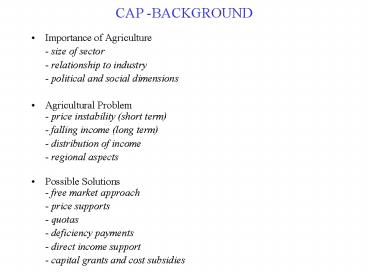CAP BACKGROUND - PowerPoint PPT Presentation
Title:
CAP BACKGROUND
Description:
Such enlargement would lead to an increase of more than 50% in the agricultural ... being met and of course additional problems may attach to further enlargement ... – PowerPoint PPT presentation
Number of Views:55
Avg rating:3.0/5.0
Title: CAP BACKGROUND
1
CAP -BACKGROUND
- Importance of Agriculture
- - size of sector
- - relationship to industry
- - political and social dimensions
- Agricultural Problem - price instability (short
term) - - falling income (long term)
- - distribution of income
- - regional aspects
- Possible Solutions - free market approach
- - price supports
- - quotas
- - deficiency payments
- - direct income support
- - capital grants and cost subsidies
2
CAP
- Objectives of CAP
- - to increase agricultural productivity
- - ensure a fair standard of living for the
agricultural - community
- - to stabilise markets
- - to provide certainty of supplies
- - to ensure supplies to consumers at reasonable
prices - Principles of CAP
- - Single Market
- - Community Preference
- - Financial Solidarity
- Financing CAP
- EAGGF (FEOGA)
- - Guarantee Section
- - Guidance Section
3
FORMER MARKET SYSTEMS
- 70 - Community Produce
- - assured minimum prices on internal market -
external protection (import levies) - 25 - External Protection (Only)
- - e.g. poultry and flowers
- Certain Products (Additional Aid)
- - e.g. wheat and olive oil
- Cotton, Tobacco and Oilseeds
- - subsidies on inputs
- Flat-Rate aids
- - flax, hemp, hops, silkworms and seeds
- Quota System
- - applied to sugar
- Unsupported Products
- - small range such as potatoes and other
vegetables
4
GUIDANCE SECTION
- Supports investments which improve the
competitiveness of farms - Schemes that improve processing and marketing and
forestry products - Schemes that promote the non-agricultural use of
farmland - Schemes that protect the environment or develop
afforestation - - LEADER scheme introduced 1991
- - incorporated since 1988 in Structural Funds
5
1992 REFORMS
- Five Objectives
- To maintain the Community's position as a major
agricultural producer and exporter by making
farmers more competitive - To bring production down to levels in line with
demand - To focus income support for farmers where it is
most needed - To encourage farmers to remain on the land
- To protect the environment and develop the
natural potential of the countryside - - price cuts linked to withdrawal of land from
production
6
MAIN MEASURES (1992)
- Price cuts for key products linked to withdrawal
of land from production. Farmers directly
compensated for loss of income - Cereals prices reduced by 29 over 3 years 93/94
- - land to be taken out of cereals production
each year in line with - forecast demand. In first year to be 15 -
does not apply to smallest - of EU cereals farmers
- Full and direct compensation for loss of
earnings - Beef prices cut by 15 over 3 years
- - Cattle on open land to receive extra premiums
and existing premiums - to be increased
- Conservation measures, improved pensions etc.
7
AGENDA 2000
- Concerned with impact of accession of Central and
European countries to the EU - Major implications for CAP financing (agriculture
is especially important in these countries) - Price increases could stimulate overproduction in
new accession countries - Further price reforms necessary with shift to
direct income support and rural development and
environmental policy - Obvious implications for Irish agriculture
8
AGENDA 2000 AND RECENT REFORMS
- Profound questions raised by prposed entry of 10
new countries (Czech Republic, Estonia, Hungary,
Poland, Slovenia, Slovakia, Cyprus, Latvia,
Estonia Lithuania and Malta) to EU e.g. cost to
EU and degree of compatibility required before
entry - Such enlargement would lead to an increase of
more than 50 in the agricultural land of the EU
and an effective doubling of the agricultural
labour force - Commission approach is to concentrate on further
cuts in intervention prices for cereals, beef and
milk, a continued switch to direct income
supports and further structural adjustment in
agricultural sector with a more environmentally
friendly approach - Explanation of terms decoupling, modulation and
degression - The intention is that natural growth in the
budget (in the region of 2.5 pa) will enable
agricultural financing to be maintained within an
overall limit of 1.27 of member states income - However this depends on a number of conditions
being met and of course additional problems may
attach to further enlargement
9
LATEST REFORMS
- In June 2003, EU farm ministers adopted a
fundamental reform of the Common Agricultural
Policy - Key elements
- - a single farm payment for EU farmers
independent of production, - though limited coupling payments may be
preserved - - payment will be linked to respect for
environmental, food safety and - animal and health issues
- - strenghtening of rural development schemes
- - a reduction in direct payments (modulation)
for bigger farms - - a mechanism to ensure that farm budget is not
exceeded till 2013 - - revision in market policies with substantial
price cuts for milk and - cereals































